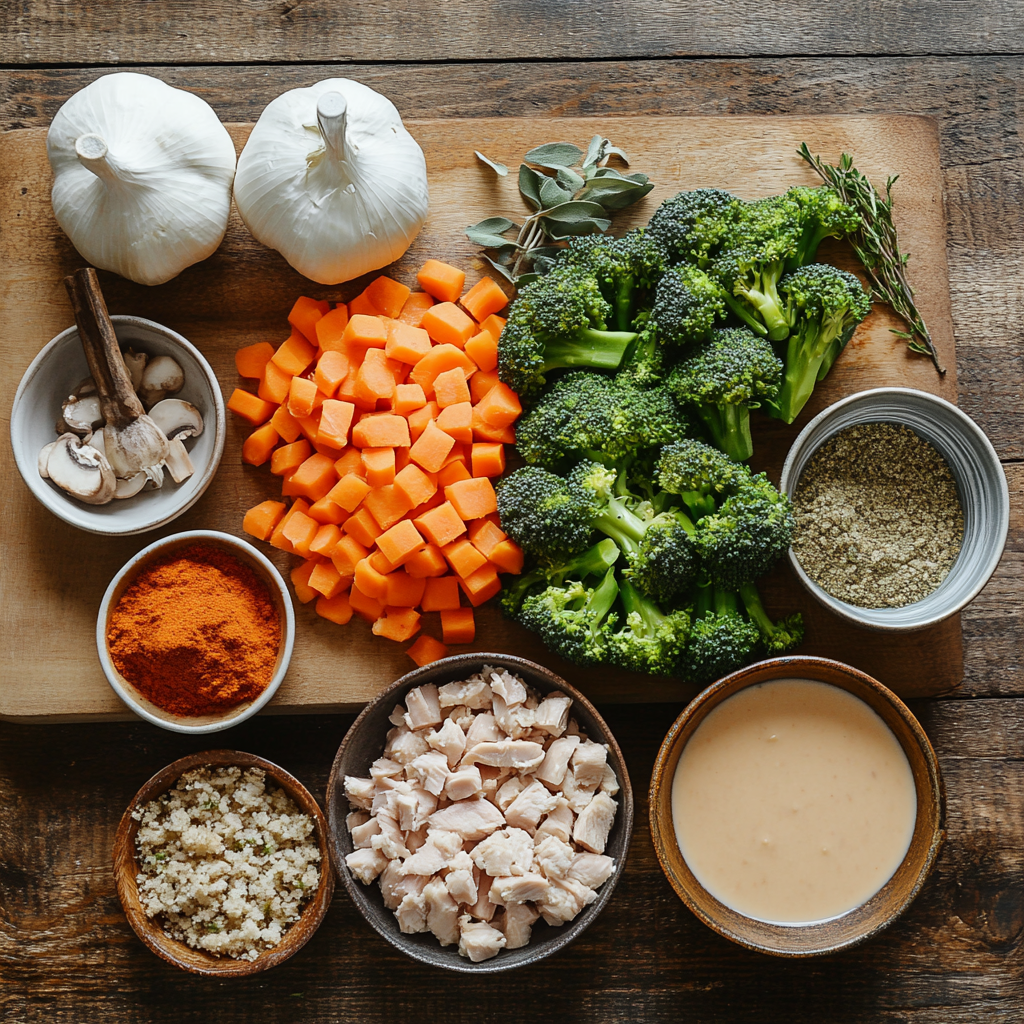Introduction:
Discover the Comfort of Turkey Stuffing Casserole
Few dishes evoke the warmth of home quite like turkey stuffing casserole. This hearty, one-dish meal captures the essence of comfort food while offering a perfect solution for using holiday leftovers or creating a delicious dinner from scratch. Picture layers of tender turkey, flavorful stuffing, and creamy sauce baked to golden perfection—it’s a meal that brings everyone to the table.
Whether you’re a Thanksgiving traditionalist or simply craving something wholesome and satisfying, this casserole is versatile enough to adapt to your needs. It’s not just about convenience; it’s about combining beloved flavors into a dish that feels like a warm hug.
Why This Casserole Deserves a Spot on Your Dinner Table
What makes turkey stuffing casserole a standout meal? Its blend of simplicity, flavor, and flexibility. You can prepare it ahead of time, customize it with your favorite ingredients, and serve it for nearly any occasion. Perfect for busy weeknights, holiday gatherings, or casual get-togethers, this dish effortlessly transitions from oven to table.
For more ideas on complementing your turkey stuffing casserole, check out this guide on the best leftover recipes. Beyond its practicality, turkey stuffing casserole is a celebration of familiar flavors. The aromatic herbs, the savory stuffing, and the juicy turkey come together in perfect harmony. It’s the kind of meal that sparks memories and creates new ones, especially when shared with loved ones.
Essential Ingredients for Turkey Stuffing Casserole
Crafting the perfect turkey stuffing casserole begins with selecting high-quality, flavorful ingredients. Here’s a breakdown of what you’ll need to make this dish shine:

Main Components
These staples are the heart of the casserole, providing texture and taste.
- Cooked Turkey
- Description: Use leftover roasted turkey for convenience, or prepare fresh turkey breast for a flavorful base. Shredded or diced, the turkey adds protein and a satisfying bite.
- Substitutions: Chicken or rotisserie chicken works wonderfully if turkey isn’t available.Check out how to make a delicious smoked turkey breast for added depth.
- Stuffing Mix
- Description: Store-bought stuffing mix is a time-saver, delivering classic flavors of sage and thyme. Alternatively, make your own stuffing with cubed bread, onions, celery, and seasoning.
- Substitutions: Cornbread stuffing adds a touch of sweetness, while gluten-free stuffing is ideal for those with dietary restrictions.
- Vegetables
- Description: Fresh or frozen vegetables like broccoli, carrots, green beans, or peas lend color, flavor, and nutrition.
- Tips: Blanch fresh vegetables before adding them to ensure they cook evenly in the casserole.
- Creamy Base
- Description: Cream of mushroom soup is a classic choice, providing richness and moisture. Cream of chicken or celery soup also works well.
- DIY Option: Create a homemade roux with butter, flour, milk, and broth for a preservative-free alternative.learn to make your own creamy soup base as shared in this comfort casserole guide.
Flavor Enhancers
These ingredients elevate the dish, making it truly unforgettable.
- Herbs and Spices
- Essentials: Sage, thyme, rosemary, and parsley complement the stuffing and turkey flavors beautifully.
- Customization: Add garlic powder, onion powder, or paprika for extra depth.
- Broth
- Purpose: A splash of chicken or turkey broth keeps the casserole moist and enhances the overall flavor.
- Tip: Use low-sodium broth to control salt levels.
- Cheese (Optional)
- Choices: Shredded cheddar or mozzarella melts into a creamy layer, while Parmesan adds a savory touch.
- Note: Cheese is not traditional but can be a tasty addition for cheese lovers.
Ingredient Variations
This dish is incredibly flexible—here are a few ideas to suit your taste or dietary needs.
- Meat-Free Option
Replace the turkey with hearty mushrooms or a medley of roasted vegetables for a vegetarian-friendly version. - Dairy-Free Version
Swap cream-based soups for coconut milk or almond milk thickened with cornstarch. - Low-Carb Casserole
Substitute the stuffing with cauliflower rice or a blend of chopped zucchini and squash.
With these essential ingredients and variations, you’re well on your way to crafting a turkey stuffing casserole that suits your needs.
Step-by-Step Recipe Instructions
Creating a turkey stuffing casserole is a simple and rewarding process. Follow these detailed steps to achieve a perfectly layered, flavorful dish every time.
Preparation
- Gather Your Ingredients
- Ensure all ingredients are ready to go: cooked turkey, stuffing mix, vegetables, cream soup, broth, and optional flavor enhancers like herbs or cheese.
- Preheat the Oven
- Set your oven to 375°F (190°C) to ensure it’s fully heated when your casserole is ready to bake.
- Prepare the Stuffing
- If using a boxed stuffing mix, follow the package instructions to prepare it. Homemade stuffing should be fully seasoned and moist but not soggy.
- Cook the Vegetables
- For fresh vegetables, blanch them in boiling water for 2–3 minutes to soften slightly. If using frozen vegetables, thaw and pat them dry.
- Shred or Dice the Turkey
- Cut your cooked turkey into bite-sized pieces for easy layering.
Assembly
- Grease the Baking Dish
- Use butter, oil, or cooking spray to coat the bottom and sides of a 9×13-inch baking dish.
- Layer the Ingredients
- First Layer: Spread the turkey evenly across the bottom of the dish.
- Second Layer: Add a layer of vegetables, distributing them evenly for balanced flavor.
- Third Layer: Pour the cream of mushroom soup (or your chosen alternative) over the turkey and vegetables, smoothing it out with a spatula.
- Final Layer: Top with prepared stuffing, pressing lightly to create an even layer.
- Add Optional Toppings
- For added crunch, sprinkle breadcrumbs or crushed crackers on top. If using cheese, add a layer here for a golden, bubbly finish.
Baking
- Cover and Bake
- Cover the casserole with aluminum foil to retain moisture. Bake in the preheated oven for 20 minutes.
- Uncover and Finish Baking
- Remove the foil and bake for an additional 15–20 minutes, or until the stuffing is golden brown and the casserole is heated through.
- Check for Doneness
- Ensure the casserole is bubbling slightly around the edges, and use a thermometer to confirm a temperature of 165°F in the center if reheating leftovers.
Serving Suggestions
- Portion and Plate
- Allow the casserole to cool for 5 minutes before serving to let the layers set. Use a large spoon or spatula to dish out portions.
- Accompaniments
- Serve with a crisp green salad, cranberry sauce, or roasted vegetables for a balanced meal.
- Presentation Tip
- Garnish with fresh parsley or thyme for a touch of color and an added layer of freshness.
For more casserole inspirations, explore this Wikipedia article on turkey stuffing casserole for historical insights and preparation variations.

Tips to Customize Your Turkey Stuffing Casserole
One of the best things about turkey stuffing casserole is its flexibility. Whether you’re working with leftovers, accommodating dietary needs, or simply craving a twist on the classic, there are plenty of ways to make this dish your own.
1. Incorporating Leftovers
Transform holiday extras into a complete meal with these ideas:
- Cranberry Sauce
- Add a layer of cranberry sauce between the turkey and vegetables for a sweet-tart contrast.
- Mashed Potatoes
- Replace or layer the stuffing with mashed potatoes to create a shepherd’s pie-inspired variation.
- Roasted Vegetables
- Use roasted Brussels sprouts, sweet potatoes, or carrots for a caramelized depth of flavor.
- Gravy
- Drizzle leftover gravy over the turkey layer before adding vegetables for extra richness.
2. Dietary Modifications
Adjust the recipe to suit specific dietary preferences or restrictions:
- Gluten-Free Casserole
- Substitute the stuffing mix with gluten-free stuffing or use cooked wild rice for a hearty, gluten-free option.
- Dairy-Free Version
- Use plant-based cream alternatives, such as coconut cream or almond milk, in place of cream of mushroom soup.
- Low-Sodium Dish
- Opt for unsalted broth and low-sodium soup to control salt levels. Avoid pre-seasoned stuffing mixes if necessary.
- Vegetarian Option
- Skip the turkey and use a mix of hearty vegetables like mushrooms, zucchini, and eggplant. Add cooked lentils or chickpeas for protein.
3. Enhancing Flavor and Texture
Take your casserole to the next level with these enhancements:
- Cheese Topping
- Sprinkle shredded cheddar, Monterey Jack, or Parmesan over the stuffing for a creamy, golden crust.
- Crunchy Additions
- Add a layer of crushed crackers, crispy fried onions, or panko breadcrumbs on top for extra crunch.
- Herb Infusion
- Mix fresh or dried herbs like thyme, sage, or parsley into the stuffing or creamy base for a fragrant boost.
- Seasonal Twists
- Incorporate seasonal produce, such as butternut squash or cranberries, for a festive variation.
4. Personalizing for Your Family
- Kids’ Favorites
- Mix in shredded cheese or mild seasonings to make the dish more appealing to younger palates.
- Spice It Up
- Add a pinch of red pepper flakes or a splash of hot sauce to the creamy base for a subtle kick.
- International Flair
- Add Mediterranean flavors with olives and feta or Asian-inspired notes with soy sauce and sesame oil.
Frequently Asked Questions (FAQ)
Here are some common questions about turkey stuffing casserole, along with concise answers to assist you in preparing this comforting dish.
Q1: Can I prepare turkey stuffing casserole in advance?
Yes, you can assemble the casserole up to 24 hours before baking. Cover it tightly and store in the refrigerator. When ready to bake, let it sit at room temperature for about 30 minutes, then bake as directed.
Q2: How do I store and reheat leftovers
Store leftover casserole in an airtight container in the refrigerator for up to 3–4 days. To reheat, cover with foil and warm in a 350°F oven until heated through, or microwave individual portions until hot.
Q3: Can I freeze turkey stuffing casserole?
Yes, you can freeze the assembled, unbaked casserole. Wrap it tightly with plastic wrap and aluminum foil, then freeze for up to 2 months. Thaw in the refrigerator overnight before baking. If baking from frozen, increase the baking time and ensure the internal temperature reaches 165°F.
Q4: What side dishes complement turkey stuffing casserole?
Pair the casserole with a fresh green salad, steamed vegetables like green beans or broccoli, or cranberry sauce to balance the rich flavors. Dinner rolls or mashed potatoes also make excellent accompaniments.
Q5: How can I make this casserole gluten-free?
To make a gluten-free version, use gluten-free stuffing mix and ensure that other ingredients, such as soups or broths, are certified gluten-free. Always check labels to confirm.
Q6: What can I substitute for cream of mushroom soup?
If you prefer a different flavor or need an alternative, you can use cream of chicken or cream of celery soup. For a homemade option, prepare a white sauce with butter, flour, and milk, seasoning it to taste.
Conclusion
Turkey stuffing casserole is more than just a meal—it’s a celebration of comfort and tradition. With its layers of tender turkey, flavorful stuffing, and creamy goodness, this dish brings together the best of holiday flavors in one convenient, crowd-pleasing package.
Whether you’re using up Thanksgiving leftovers or preparing it from scratch, this casserole offers endless customization options to suit any occasion or dietary need. From adding a cheesy topping to incorporating your favorite vegetables, the possibilities are as varied as your creativity.
Now it’s your turn! Gather your ingredients, follow the simple steps, and enjoy the warmth of a homemade turkey stuffing casserole. Don’t forget to share this recipe with friends and family—it’s bound to become a new favorite at your table.

